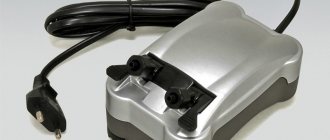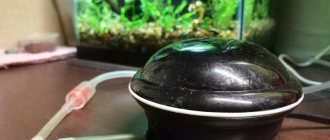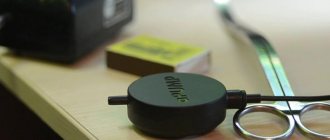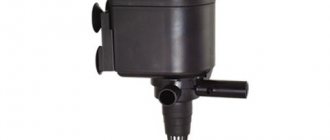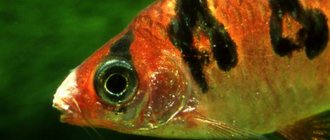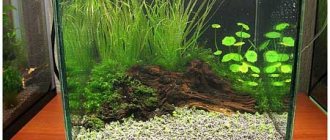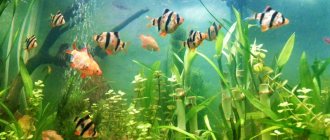A compressor should be in every aquarium - this is the key to saturating the water with enough oxygen so that fish and underwater plants feel good. However, many models of compressors make a lot of noise during operation, which simply unbearably interferes with sleep at night. Of course, progress does not stand still, and manufacturers have already begun to produce more comfortable devices. So, choose a quiet, silent compressor for your aquarium.
What types of compressors are there?
All modern compressors for aquariums are divided into two types (by design):
- membrane;
- piston
Piston engines operate using a piston, under the influence of which the generated air flow comes out. Such models usually have high power and are suitable for large aquariums. They serve for a very long time.
Membrane aquarium compressors generate air using special membranes. They consume little electricity, however, their operating power will not allow them to enrich a large tank of over 150 liters with oxygen.
A common feature of both types of aerators is the high level of noise produced during operation. However, the technologies themselves make it possible to create new developments where the noise will be much lower, or there will be none at all.
Today, almost all manufacturers have in their assortment membrane compressors for aquariums, the volume of which depends on the electric armature of the drive and the degree of vibration of the membranes. It is worth remembering that the concept of “noisiness” is individual; this threshold is different for each person. Therefore, measurements of acceptable noise levels are often made using a special “Sound Meter HQ” application for smartphones and tablets. Why exactly this? Because it has the ability to measure low noise sound below 10 decibels, while professional sound level meters usually have a minimum noise threshold. The application can even recognize a person’s breathing.
You can easily choose a quiet and silent compressor for your aquarium from the options listed below.
How to attach the device
There is nothing complicated about installing a compressor. It is enough to follow the instructions provided by the manufacturer. The main condition for installation is to check the strength and hardness of the object being placed on the surface. There should be no tilts or rolls. If this requirement is not taken into account, the compressor may fall over time, since its operation is associated with vibration. Do not allow excessive tension on the air hose and electrical wire.
Experts recommend strictly following the following installation rules:
- Before making a final decision regarding the model, you need to determine whether it fits your electrical system. The data is specified in the instructions attached to the product. If you have doubts about the correct choice, it is better to consult your sales manager. It is worth keeping in mind that too much power will lead to discomfort for the inhabitants of the tank. To avoid a powerful current, you will have to use a hose clamp. There is no need to overpay for the electricity used, or to change an overheated motor.
- Selecting an installation location. The classic section is above the water level. This will save energy and reduce noise. If you install the device below the water level, it may get inside, which will lead to damage to the unit. The worst outcome is flooding of the neighbors below. It is strictly forbidden to install the aerator on the lid of the aquarium. Noticeable vibration will inevitably lead to rattling of the glass container, and possibly to its cracking. The best option is wall mounting. To do this, just build a shelf, use a tabletop, or use nails or a hook for hanging. A prerequisite for the location of the structure is optimal distance from sockets, switched on electrical appliances or extension cords.
- Selection of fasteners. Special mountings are required for the sprayer and hose. You should take care of them in advance. These devices are placed on the bottom and firmly fixed to prevent floating. For this purpose, you can use aquarium decor in the form of a ceramic amphora, pebbles, stone slides, shells, and driftwood. When the sprayer floats up, the efficiency of aeration will become almost zero. There is not enough time for oxygen to dissolve in the water before it reaches its surface.
- Rules for installing the sprayer and hose. The location for the compressor tube is selected in close proximity to the water heater. The flow created by the aerator will equalize the temperature of the liquid throughout the tank. The air intake hose must leave the aquarium. The optimal place for the sprayer is the back wall of the tank. There he will be safe and will not interfere with the enjoyment of contemplating the fish. The hose is masked with plants and dug in.
- Installation of a check valve. Necessary if the compressor is located below the water level. The valve membrane can only open in one direction, allowing liquid to flow into the aquarium, while blocking the hose when it flows back. Before installation, the hose is cut crosswise. Afterwards, both parts of the hose are attached to the nozzles of the check valve. As soon as the hose is inserted into the compressor, aeration can be turned on.
- Checking the compressor for functionality. If there is a strong noise after turning on the compressor, you should take care of installing it on a foam base. You can also use foam rubber or other soft fabric for bedding. If the aerator is installed correctly, it will demonstrate its effectiveness within a couple of hours. It is worth carving out free time and observing the behavior of aquatic inhabitants. For them, nothing should change regarding the habitat layer. If you see that bottom fish rise to the surface and spend a lot of time there, then it is worth increasing the power of the unit.
Collar
The aPUMP compressor from Collar is the leader in all tests.
If you read aquarium forums, you can see that professionals claim that his work is almost inaudible. The manufacturer claims a noise level of 35 dB, but in fact the result turned out to be much better - only 7 decibels. (Remember that the permissible noise level according to standards in a room intended for sound recording, equipped with insulation, is 2 dB).
Collar aPUMP is effective in aquariums with a volume of less than two hundred liters; This is currently the most compact and quietest aerator in the world. It is also effective in high aquariums up to 80 centimeters deep due to the powerful air flow. At a water height of 50 cm, it produces noise of no more than 10 decibels.
The best compressors for large aquariums (over 250 l)
For large aquariums or deep decorative panels, you will need multi-channel powerful devices with a capacity of 400 l/hour and higher. To push water to a significant depth, significant power of 5-8 W is required.
Schego WS3(IO)
5.0
★★★★★
editorial assessment
100%
buyers recommend this product
The device with a capacity of 400 l/hour and a power of 5 W is specially designed for pumping air to a depth of 2 meters in a large aquarium. A special feature of the model is the plugged air intake hole to prevent dust and moisture from entering there. At the same time, if there is a power outage and the compressor is lowered below the water level, you do not have to worry about liquid leakage.
Pros:
- Stable, constant work without any complaints;
- Rubberized feet protect against vibrations;
- Air filter;
- High-quality assembly;
- Can be installed below water level.
Minuses:
- Expensive.
The aerator can be used in bubble panels without having to worry about regularly adding water. Such units can pump humid air and air containing various impurities, and operate in a closed circuit with inert and non-viscous liquids, colored water or oils.
Ferplast AirFizz 400
5.0
★★★★★
editorial assessment
100%
buyers recommend this product
A powerful device with a capacity of 400 l/hour is designed to supply air into water to a depth of 1 m. The energy consumption of 5 W is enough to provide oxygen to a 400-liter container. The piston apparatus has two outlet pipes with the ability to adjust the air flow on each. The device operates quietly and is equipped with vibration protection. The compressor comes with all the accessories necessary for its operation.
Pros:
- It is possible to attach horizontally to a special loop above or below the water level;
- Fully equipped with all hoses and check valves;
- Air flows are smoothly adjustable;
- Can aerate one or more tanks;
- High quality build and materials.
Minuses:
- It's not cheap.
A good, fairly quiet piston device, the power of which is enough to effectively “punch” air through a two-meter hose. The model can simultaneously aerate several fairly large aquariums.
EHEIM
The EHEIM company (Germany) calls the aerators it produces the quietest, and indeed, they also show excellent results. The manufacturer paid special attention to the mechanism that determines the movement of air masses: the membrane is made of a special type of rubber with integrated magnets, due to which the anchor is no longer needed, and therefore less noise.
The design of the case has undergone no less modification - modern noise suppression technologies have been fully applied to it. In addition, the compressor is hung vertically, so vibration does not transfer to the table or other resonating objects.
The kit includes a diffuser with which you can easily adjust the activity and size of the bubbles. According to measurements, the device produces a noise of 18-21 dB (the range depends on the power of the aerator).
JBL
JBL has a whole “silent” line called JBL ProSilent. Despite their virtually silent operation, their compressors fully provide aeration for aquariums of various sizes (from 40 to 600 liters).
The noise level demonstrated during measurements was 20 dB (if you choose the smallest model) and 30 dB (for the largest ones). The manufacturer also warns that the sound level may increase over time due to dust on the air duct gasket and limescale contamination of the sprayer. However, these spare parts can always be replaced.
What to choose: a compressor or an aeration filter?
If you have an aquarium with a capacity of more than 200 liters, you definitely need a powerful compressor. Only powerful equipment ensures effective saturation of a large volume of water with oxygen and its proper mixing throughout the entire depth of the aquarium. In addition, rising air bubbles have a better effect on the aesthetics of the composition.
In some cases, at first it seems that a compressor is not needed, but then it becomes obvious: the fish do not have enough oxygen. This occurs due to an increase in water temperature in summer, a change in the number of inhabitants, and a decrease in the volume of growing living plants.
An aeration filter is suitable for small aquariums that are not overcrowded with fish. It is not advisable to use it instead of a compressor. The disadvantages are:
- deterioration of water filtration - occurs due to the fact that to capture oxygen, the device is placed in the upper part of the aquarium; sediment from the bottom simply cannot be drawn in;
- instability of saturation - oxygen intake for further dissolution stops if the porous filter material is clogged;
- dependence of aeration on the installation height - saturation of water with oxygen is possible only when the filter is located closer to the surface of the water: if the device sinks to the bottom, bubbles will not flow.
Despite the fact that a filter with an aeration function is cheaper, the operational efficiency and capabilities of the devices must be of paramount importance. The desire to save money can lead to the death of fish.
Tetra
Another well-known German company produces compressors with slightly higher noise generation. When developing the design, engineers took into account all the disadvantages of their previous models, as a result of which the new devices are equipped with special noise-insulating housings made of dense material, and the membranes are made of highly elastic rubber.
The most compact aerator from the silent line is suitable for use in small aquariums (10-60 l). At the same time, it produces a noise of approximately 26 dB. If you are choosing a compressor for a large tank (up to 600 l), then choose the Tetra APS-400 model. Its noise level is 37 dB, which can be compared to the slight rustle of paper in a spacious classroom.
Tetra, according to reviews from professional aquarists, always overheated during operation. This point was also taken into account. The new models do not have this disadvantage. You can also note the stylish modern design, which plays a significant role in the popularity of the company.
How to make the right choice
The aquarist will need to choose the right specific modification of the compressor, which will ensure optimal living conditions in the aquarium for fish and other aquatic organisms. When choosing, you must consider the following indicators:
- device price;
- power;
- durability;
- noiselessness.
When choosing a silent aquarium compressor for a large-volume tank, you can purchase either one powerful device or several low-power models at once. The latter will be preferable, since powerful compressors make more noise, and if one of the two low-power devices breaks down, the second one will still work and properly aerate the aquarium, which will prevent fish death.
Currently, products from various manufacturers of aquarium aerators are on sale. The most popular equipment today is from brands such as Tetra, HAGEN, Aquael, JBL and others.
When choosing a silent aquarium compressor for a large-volume tank, you can purchase either one powerful device or several low-power models at once.
Aquael
The Aquael company produces several product lines, among which OXYPRO and OXYBOOST are quite popular. Aquael devices have always been in demand due to their high power, but this advantage was associated with strong noise.
Innovative models use elastic noise-absorbing materials, double-walled housings and an unusual magnet design. Therefore, at the moment, Aquael compressors are a harmonious combination of power and quiet operation. For example, the OXYPRO 150 aerator shows a noise level of 35 dB and is capable of working with a depth of up to 200 cm. And if you have a shallower aquarium (most likely, this is the case), then you do not need to turn on the device at full power. Accordingly, the noise will be even lower.
Device selection criteria
Selecting a compressor and calculating the required power of the device is not so simple. You walk into a store and your eyes widen at the abundance of available options. Don’t rush to buy the first device you come across, focusing only on the reasonable price. First, “do your research.” It is necessary to take into account many seemingly insignificant little things. And this is by no means an aesthetic appeal.
Important criteria for selecting a compressor:
. This parameter directly depends on the volume of the aquarium, because oxygen will be distributed throughout the entire perimeter, and an excess can cause harm rather than benefit. Optimal indicators are 0.8 per liter of water, adjusted for population level. For densely planted herbal plants, productivity can be increased by 10%.
Performance- Power . This criterion is directly related to productivity. It is important to take it into account solely for the purpose of saving energy.
- Size . For large aquariums, universal devices with high power and performance are suitable. Small compressors are enough for small ones. Recently, miniature models have appeared on the market, which are worth paying attention to when maintaining small herbal aquariums.
- Manufacturer . The leaders in the production of equipment for aquariums are German brands. The most popular are Schego and Eheim - brands tested by many aquascapers. But there are also lesser-known companies that supply equally high-quality equipment. For example, Aquael, Tetra, Collar.
Different brands may have additional characteristics: the presence of a retainer, a filtration system, and the like. They do not have an important structural significance, but they add comfort to the use of the equipment and accordingly increase its cost.
As for the choice of sprayers, taps, and other “accessories,” use what you like. There is no big difference in the choice of accessories and there is no fundamental difference in their operation.
But each option has pros and cons:
- Flexible hoses with a fine spray produce a lot of beautiful bubbles - this is their advantage. But the holes get clogged quickly and are difficult to clean.
- Stones are more practical in terms of maintaining cleanliness.
Schego
Schego is a company also founded in Germany. Moreover, it has been on the market for 60 years. Compressors manufactured by Schego have a minimalistic appearance - a transparent body with smooth shapes, through which you can see the entire internal structure of the unit.
Tests also show good results. The compressors are very powerful, designed for large tanks of 100-300 liters, but at the same time they are even quieter than the Tetra mentioned above. It's all about the special material of the legs, which, despite their small size, effectively smoothes out vibration.
The most modest aerator from Schego, called the PRIMA 100+, shows 30 decibels when calculated for a 100-liter aquarium. The most powerful one (model M2K3) shows 35-40 dB, which is also quite acceptable.
Piston or membrane?
The most common types of aquarium compressors are piston and diaphragm.
- Piston . Durable, productive and - most importantly - very quiet. They are expensive. As a rule, these are powerful models that are suitable for deep aquariums, incl. for columns.
- Membrane . They have a smaller work resource. Not as powerful as piston ones, therefore not suitable for deep tanks. They make a lot of noise, but they benefit in terms of cost.
Not long ago, virtually silent piezo compressors appeared on the market. But they are low-power, which makes them absolutely unsuitable for deep aquariums with a volume of more than 150-200 liters.
Hagen
The company produces a very wide range of different aerators, quiet and not very quiet. In particular, the Fluval Q2 model, which is capable of working with tanks with a volume of 40-600 liters, is characterized by low noise. The smallest models in size and power produce approximately 35 dB of noise; the most massive - no more than 45.
The secret lies in double walls and multi-chamber. There are special partitions between the cells. This design ensures exceptionally quiet operation combined with a continuous and strong air flow.
Operating rules
Timely maintenance of the compressor is the key to long-term operation. The manufacturer may indicate the frequency of cleaning and replacement of compressor components in the instructions.
A common cause of device failure is burnout due to fluctuations in network voltage. The compressor begins to heat up as the voltage increases. For economic reasons, some manufacturers design the inductor winding at 220 V. When the voltage increases by 15-20 V, the compressor temperature rises and heating occurs. The norm is considered to be the heat of a working device that can be felt by the hand.
Resun
The Chinese compressor positions itself as silent, but test results show a completely different result. Even if the aerator was relatively quiet when purchased in a store, after just a couple of months the volume is 45 dB, plus there is strong heating of the body. In addition, the warranty on most models is only six months.
Chinese Resun has a low price, which is why they attract customers, especially beginners. But the controversial question is whether it is worth saving in such a matter.
FAQ: 5 answers to questions for a beginner from an aquarist
Is it possible to take a compressor with a power 1.5-2 times higher than required? Is extra power good?
Recommends choosing a technique based on the acceptable level. Due to too strong aeration, which can be observed when purchasing a compressor that is too powerful, small fish will be “tossed around”, and the turbidity from the bottom will rise up. If there are living plants, they will not be able to develop in such conditions: strong aeration will blow out the necessary CO2.
I made a mistake and took an aerator that was too powerful. Is it worth changing it?
If your appliance does not have a regulator, you can use a shut-off tap. However, it is better to change the model to one that is optimal in terms of power: due to overlap, the compressor membrane wears out faster.
Is it possible to place the compressor under the aquarium, for example, in a cabinet?
Yes, this arrangement will help reduce the noise of the equipment. You can pull the compressor anywhere, the main thing is that everything is connected correctly. However, it is worth remembering that when the aerator is located below the bottom of the aquarium, a check valve should be installed on the hose.
Without a check valve, when the power is turned off, water will flow down through the hoses, which can damage equipment and lead to flooding of neighbors. Among the models, Tetra Tec with a nipple membrane has proven itself well, however, even among the cheap Chinese analogues there are decent ones: rely on reviews.
Where to install the check valve?
If you place the valve closer to the aerator, water will fill the tube completely to the section where it is installed. It is optimal to place the valve on the hose, above the water level. So, when starting up, the aerator will need to push out water only in a small section: from the valve to the disperser tube.
Is a compressor necessary if there is an aeration attachment for the internal filter?
Under such conditions, if you direct the air flow so that small ripples are created on the water, then one filter will be enough. However, it is better to install a compressor. Firstly, it is useful in treating fish when it is necessary to increase aeration. Secondly, fine bubbles are often fed through the bell, which impairs the solubility of oxygen in water and increases the noise of operation.
How to reduce noise level if the compressor is already old?
Even if the new aerator pleases you with a low noise level, after some time the device will definitely become louder. Some models even make a buzzing sound. In living rooms this is at least uncomfortable, but installing a less powerful device will not work if the aquarium is very large. Luckily, there are a couple of ways to reduce the noise.
First, identify the specific source of the noise. If this is friction against glass or other objects, then it will be enough to place a regular dishwashing sponge (only a new one) under the device. The sponge effectively absorbs buzzing and other noise. Sometimes homemade enclosures are built for compressors from foam rubber, plastic, or wood, which provide partial sound insulation.
If even after this the noise remains strong, you can try to carefully open the device. The main thing is not to damage anything. Often the sound comes from a membrane partition pressing on the air. In this case, careful trimming of excess sections of the membrane that create noise will help.
Increased noise is also observed in case of serious contamination of the internal parts of the device. In order for the compressor to last longer, it is necessary to clean the aquarium frequently (at least once a month). If the noise comes from loose parts, you should screw them tighter.
The best compressor model in terms of quality and price
The leader among other silent aerators is Tetra APS. The compressor has sufficient power to work in both small and large aquariums with a volume of 5 to 100 liters. Its high performance is noted, because in 1 hour Tetra APS pumps up to 100 liters. Power consumption is low - only 2.5 W.
Silence is achieved due to rubberized legs and fastenings that suppress any vibration and noise. The amount of noise produced is reduced even more due to the structure of the device.
The aquarist is able to independently regulate the amount of incoming air.
The low price further increases the popularity of the compressor. You can purchase Tetra APS for about 1000–1500 rubles.

